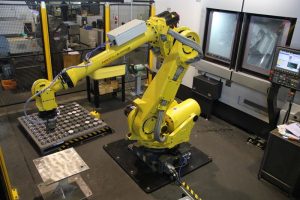ROBOTICS & AUTOMATION
Everyone knows there is a stronger focus on competitive threats and the search for productivity gains to stay healthy. But is enough really being done in the manufacturing sector to ensure survival when in fact there seems little chance salaries and wages will stall or decline and less chance the Governments will start focussing on incentives for manufacturing pressures?
Robot integration and growth is alive and well but I feel that the majority of users are those who really fit a traditional mould that is high volumes of low cost goods that have high demand from a wide variety of industries such as Food, Pharmaceuticals and appliances but most likely used for packaging. It’s likely that those obvious solutions will grow in Australia proportionately to those industry’s growth patterns themselves.
However, there appears to be a shortfall in the take up of Robots inside machine shops of manufacturers, general engineering and jobbing shops. The use of, and the assistance in achieving competitive productivity, industrial robots can deliver in those businesses is there for the taking. After all to be competitive is no great magic act. It requires a combination of cost saving, zero waste, accuracy that delivers consistency, repeatability and quality. Above all it requires imagination and innovation. Dare I quote ‘necessity is the mother of invention’!

Like our Okuma machines, robot makers such as Fanuc have refined their products in terms of operational ease and performance that encompasses speed of operation, weight carrying capacity and spatial accuracy – by quite stunning amounts from the 1980’s and 90’s days.
The matters of electronic technology, safety devices, incredible reliability rates and almost noiseless operation have really all come with a significant price reduction since the robot revolution started inside industry. This all opens the doors to tremendous outcomes of unmanned operation, lights out overnight shifts, 24/7 operation possibilities and therefore unbelievable payback rates and, importantly, throughput efficiency that allows annual volumes to surge.
Most robots will work to a +/- 0.03 -0.06mm repeatability range by the time end effector equipment is considered. At those limits, robots can easily achieve jobs that humans could not do consistently. Continuous machine loading and unloading is likely to be a clear waste of human resource and when it comes to hazardous environments whereby repeated heavy lifting is the main focus but other matters such as heat, atmosphere and even the cleanliness requirements of clean room work can all be satisfied by Robots allowing human resources to be re-applied to roles needing cognitive skills only a human can deliver.
Without doubt Robots are relentless in operation and when coupled with capable, sensibly specified and multifunctional machining equipment (for example) the productivity improvement is phenomenal. Like any CNC machine tool, robots will follow the program set without deviation in position or, most importantly, in ONLY the time taken to complete the cycle – day or night, lights on or off. Put machines and robots together and you cover the vast majority of the production process that might include complex machining, washing/cleaning, measurement verifications, boxing, sealing and palletising ready for shipment – and all with minimal human intervention.
“Robots these days, like computers or EDM machines are no longer black art.”
Of course, it’s really critical to assess the applications you intend to use a robot or robots for. There is a point where robots are better avoided in favour of dedicated hard automation. Generally this is where high volumes, multi stages of process and long-time design currency exits. Otherwise careful analysis of your shop and its capacity (part size), available space, volumes, strength of contracts, WHS peculiarities and skills will lead you to specify a robotic solution that could be redeployed often throughout its life in order to capitalise on a particular advantage its use may deliver. In reality set up time to either implement or redeploy has a small impact on the efficiency gained by applying robots to the right cause. The one golden rule is that robots cannot think for themselves so one matter is mandatory. Parts for machine loading irrespective of their complexity, material, or raw nature must be presented accurately and unambiguously to the robot in size, durable magazines or fixtures or nests be they fixed or delivered to a wait station by conveyor. The better the planning and engineering, the better the outcome and once again, the time taken to get it right will be completely absorbed if the efficiency and reliability of YOUR cell is maximized initially.
In the end, what we all want is to achieve an increase in productivity. That does not just mean faster. It means that what we produce can be achieved with HIGHER quality outcomes. LOWER rejects. BETTER human resource outcomes in health, safety and workflow. When those things are really satisfied then we go on to win on the scores of the aspects of competitive edge by faster deliveries, cost reductions and customer satisfaction and ultimately healthier margins and even an ability to bring prices down.
Whatever your ideas for improvement in a rapidly broadening global market, we would be pleased to discuss your ideas for robot implementation. We can’t run your business for you, but we can assist in advising in the areas we work in and therefore, we’d be pleased to help.